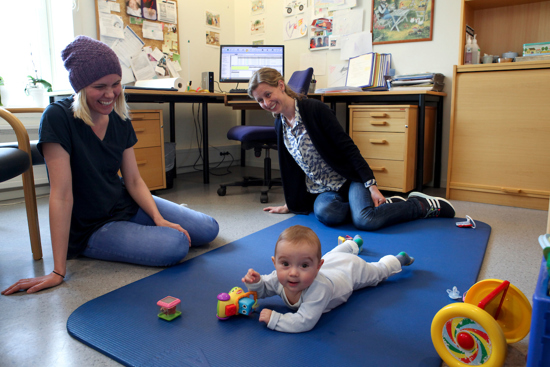How do children develop language?
Children communicate from birth and have an innate capacity for language. All children develop at their own pace, and there are significant variations in terms of their language development.
Language development in children takes place in different phases and interactions with others.
0-6 months
Children already start babbling from when they are babies. They establish eye contact, recognize and respond to sounds, make sounds and use facial expressions.
6-12 months
The child babbles and understands simple words and expressions. During this period, children recognize their name. They actively use body language together with simple words to show what they mean.
1-2 years
From 1-2 years of age, they can say simple words and short sentences. Children develop an understanding of simple instructions and questions.
2-3 years
Children learn more words and can form longer sentences. As their language comprehension increases, they often ask questions and can tell simple stories.
They use language more actively in social situations and when interacting socially with others. This includes words, movements, facial expressions and tone of voice.
3-4 years
The child continues to learn new words and form more complex sentences. Their pronunciation becomes more precise. They can talk to you about things that are going to happen in the near future, and about events that have occurred in the recent past.

Infant healthcare programme, age 0–5 years
The infant healthcare programme for children aged 0-5 years is a free service for children and parents available in their municipality.
Illustration: Rebecca Ravneberg / Helsedirektoratet
Stimulate your child’s language development
Eye contact, interaction and security are important for your child to be able to experience normal language development. When children feel secure, they are more open to exploring language and communicating.
Remember that infants do not give clear signals. Pay attention so that you are aware of when your child is trying to communicate.
Children can learn multiple languages at the same time, so use your native language actively. Speak to your child in the language you know best. This provides your child with a richer linguistic experience and helps them link words to emotions and experiences.
You can support and influence your child’s language development
- Use everyday situations to play and have fun with the language.
- Start reading books to them at an early stage, choose books with pictures suitable to your child’s age, and point to the pictures you are talking about.
- Organise play sessions with other children to promote linguistic and social skills.
- Pay attention to your child and put away your mobile phone and headphones.
Tips for conversation
- Listen to and imitate your child's sounds from the time your child is born.
- Give your child time to respond with sounds and gestures.
- Put into words how you think your child expresses themselves and feels.
- Put into words what your child is looking at and what you are doing together.
- Make sense of the words your child is saying. For example, if your child says “dog,” you can say “Yes, it’s a big dog barking.”
- Use repetition, rhythm and singing to make language more fun and easier to remember.
Ask for help if you have any concerns
If you are concerned about your child’s development, please contact the health centre or kindergarten. They are knowledgeable about language development in children. By observing and assessing, they can advise you on your child’s language and potentially refer you to other support services.